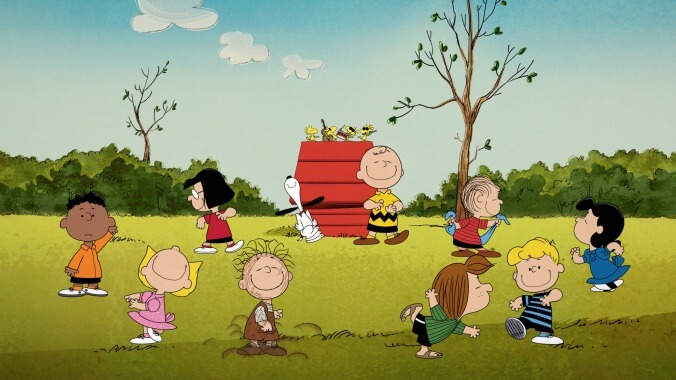The appealing Snoopy Show may stretch viewers’ love for the iconic dog


A few years back, there was a bit of an online fervor over whether or not Snoopy killed Peanuts. Charles M. Schulz’s most iconic character, from his classic comic strip filled with memorable ones, can sometimes be overwhelming, but Snoopy’s core characteristic is that he’s meant to be a lively agent of positive(ish) chaos. Charlie Brown and company may live in a cynical, melancholic world that rarely shies from presenting a wide swath of failures and disappointments to its child audience, but that world also allowed for bouts of sheer weirdness that loosened things up, often playing with the medium itself. Snoopy is just the epitome of Schultz’s more sillier flights of fancy–often literally, what with the beagle’s frequent aerial battles with the illusory Red Baron.
But Snoopy can be too much at times, and The Snoopy Show could be a test of viewer patience with the iconic dog. Apple TV+ acquired the film rights to nearly the entire Peanuts library, and while an ill-advised move to air those films solely on its streaming channel got squashed, it’s clear that the streamer still wants to mine a specific voice and symbol from the brand that can stand on its own. The most recent adaptation, The Peanuts Movie, feels like the main inspiration and standard bearer for this current version. Peanuts’ earnest, off-beat black comedy core has, over the years, transitioned from a slightly quirky, somber satire in which life can suck (and how to work through the suckiness) to a more slight, cringe-based comedy offering, like The Office (U.S.) or Meet The Parents. Charlie Brown still gets the brunt of bitter nonsense thrown his way, but rarely are we sitting with him through the misery and embarrassment. Instead, his issues are presented as fodder for visual gags and hilarious asides, as The Snoopy Show sets out to make Snoopy the Peanuts representative, the connective figure of the various Peanuts characters and the brand as a whole.
It’s not necessarily bad thinking, but the approach is questionable. Snoopy was mostly silent in previous iterations, letting out the occasional high-pitched yelp when hurt or frustrated. The Snoopy Show has him chirping incessantly, along with his partner Woodstock, evoking the nonsensical noises of the infamous Minions. Each episode is composed of three seven-minute shorts, so nothing goes overboard or too long. Each installment involves Snoopy getting into some kind of scrap or situation, elevating the wackiness a bit beyond even the sillier moments of Schulz’s original comic. The animation and visuals are beautiful and clean, but not so much that they look flat and computerized. The characters designs are perhaps a bit too sharp, but the backgrounds and settings are delightfully evocative of that classic Bill Melendez look, the watercolors slightly seeping past the hand-drawn lines. Gags are propped up occasionally with comic strip-esque details, such as written-out onomatopoeia, blackened scratch-balls floating above angry faces, and dust clouds erupting when characters take a tumble. The voices are great (the casting of Lucy and Linus in recent Peanuts entertainment continue to be spot-on), and the music remains in harmony with Vince Guaraldi’s classic scores, although it is a bit more frantic, if only because some of the antics are.
The core personalities of the Peanuts gang are still intact, and are sometimes given a bit more oomph. (It’s nice to see more of Peppermint Patty’s overall athletic prowess.) But this definitely is a show focused on Snoopy. The best shorts pull in the various human characters into Snoopy’s direct orbit. The first episode provides slightly canonically inaccurate Cliff Notes on the story of how Charlie Brown adopted Snoopy, and how Snoopy met Woodstock, both of which are brief but quietly endearing. Episode four’s “Happiness Is A Warm Blanket” segment sees Snoopy at his most earnest, as he tries to help Marcie enjoy a snow day. But most of the episodes are focused on the pooch’s various antics. An entry where Snoopy has to bring Sally her lunch while imagining he’s in a war zone is mostly frustrating, even at seven minutes; a later bit where Woodstock falls in love with a shuttlecock from a badminton game is just too absurd to enjoy.
The timing and execution of many of the visual jokes is sharp, even with weak premises and the dedication to that classic visual style (which is a good thing and a far cry from that bizarre “bubble” movement in the franchise’s last TV outing). There are classic, recognizable gags, like Lucy’s acerbic putdowns and Patty’s inability to recognize Snoopy as an actual dog, and some more “modern,” cartoon-ier gags, like an extended bit where Snoopy tries to do chores for Lucy but completely screws things up in over-the-top ways. The Snoopy Show generally eschews dark comedy and only dabbles in the more philosophical struggles of the ways life can be a dark, consistent drag, where small moments of joy or contentment can feel momentous, mostly depicted through Charlie Brown himself. Beyond that, it’s a pleasant, funny, weightless affair that manages to evoke the feeling of Charles Schulz’ seminal comic strip, but not its meaning. But hey, Snoopy is fun.